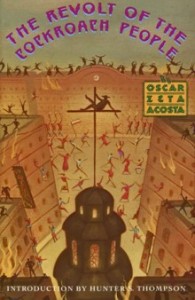Book Review “Revolt Of The Cockroach People”
 By Luis Torres, Latinopia
By Luis Torres, Latinopia
“Revolt” was the second book by Acosta, the rumpled attorney who passed the bar by the skin of his teeth and exuberantly joined in the noisy street activism of the Chicano movement in East L.A. in the late 1960s and early 1970s. And wasn’t that a time! His first book was “Autobiography of a Brown Buffalo,” which bears as much resemblance to genuine autobiography as “The Autobiography of Alice B. Toklas” by Gertrude Stein. It wasn’t a conventional autobiography to say the least.
Acosta is probably best known for his friendship/partnership with the wild man of letters, Hunter S. Thompson, and for the mysterious circumstances of his death (or disappearance) in Mexico in 1974. Both Acosta and Thompson made no secret of their ardor for hallucinogenic drugs, distilled spirits and the social chaos those elements ignited. It appears that in his life Acosta might have had difficulty distinguishing reality from illusion.
And that is certainly the case with his book, “The Revolt of the Cockroach People.” Are the events he depicts “real” or are they creations of his imagination? Is the book “documentary” or is it “fiction”? With this book, it’s impossible to tell. For some readers, that’s its charm. For me, that’s its problem. Of course, writers have blended fact and fiction before with genuine success. We all remember Truman Capote’s “non-fiction novel” “In Cold Blood.” That’s an exquisitely written book, no doubt. But I’ve always had problems with its schizophrenia. In some cases Capote uses real names involved in that gruesome murder at the core of the book. In other cases, he invents characters – and scenes and dialogue and everything else, as you would in a conventional novel.
Acosta’s “The Revolt of the Cockroach People” suffers from the same problem, and to a much greater degree. The book is certainly a milepost when it comes to accounts by and about Chicanos. It was among the first generation of books that sought to tell some of our stories, from our point of view. It has its moments, that’s for sure. But it suffers from some weaknesses as well.
Its apparent attempts at a kind of stream-of-consciousness approach more closely resemble unbridled ramblings of someone not unfamiliar with a certain wacky tabacky. And there’s the big issue of “what’s real” and “what’s invented” throughout the book. Lawyers like to question witnesses who seem to have made contradictory statements by asking, “Were you lying then, or are you lying now?” Whatever the answer, the jurors are not likely to look favorably on the testimony of such a witness being grilled.
In Acosta’s case, this is an issue that detracts from the potential of the book. (And there are a few tightly written passages with some laudable satirical humor in the book.) You can’t have it both ways. Either you are documenting (and sometimes skewering) actual pivotal events of the Chicano movement, or you are just making things up. He writes the book as if it were “real,” but it is unequivocally NOT. As it happens, I was there at some of the events he describes. I knew the people he talks about, with their names changed. The minute you are emancipated from being accurate, then you have license to “make things up.” And that’s okay when it’s demonstrably fiction. But it’s not okay when it’s fiction masquerading as fact.
But let’s put that issue aside for a moment. Let’s look at other dimensions of the book. Is the book engaging? Are there characters that captivate you? Is there some sort of intriguing dramatic movement that builds in the story? Is it a story well told? Sadly, the answer is generally “no” to all of the above? So, why did we read it so eagerly when it was first published back in 1973? Partly, I think, because we as Chicano were so desperate to read anything about “us” that wasn’t written by some gringo with an anthropologist’s magnifying class in one hand and an English-Spanish dictionary in the other. Hey, one of “us” wrote a book about us, let’s read it.
Acosta “documents” his participation in the aftermath of key Chicano events such as the activism of Catolicos Por La Raza to urge the Los Angeles Catholic Archdiocese to spend money on the poor instead of on lavish architectural moments, the police brutality at the Chicano Moratorium of 1970, the killing of journalist Ruben Salazar by an L.A. County Sheriff’s deputy and the earth-shaking East L.A. school walkouts. But his telling of those tales suffers from that “fact” versus “fiction” dichotomy. It gives the impression of a book cobbled with apparent haste and held together with chicle and duct tape. It’s worth reading, but when it comes to veracity about key historical events of the Chicano Movement, consider the book with a grano de sal.
This article was first published in Latinopia.
Luís Torres is the author of the forthcoming book “The Children of Doña Julia: The Life and Legacy of Vahac Mardirosian.”
[Book cover by Vantage Books]
